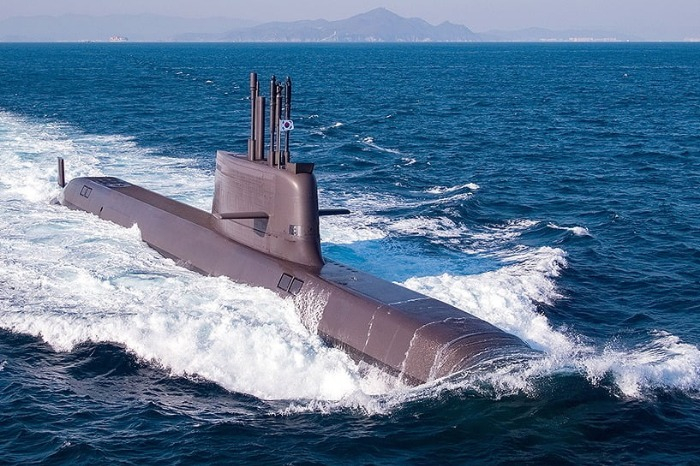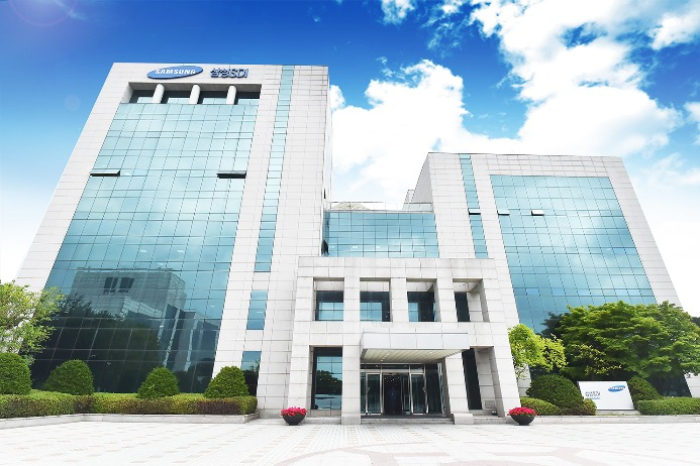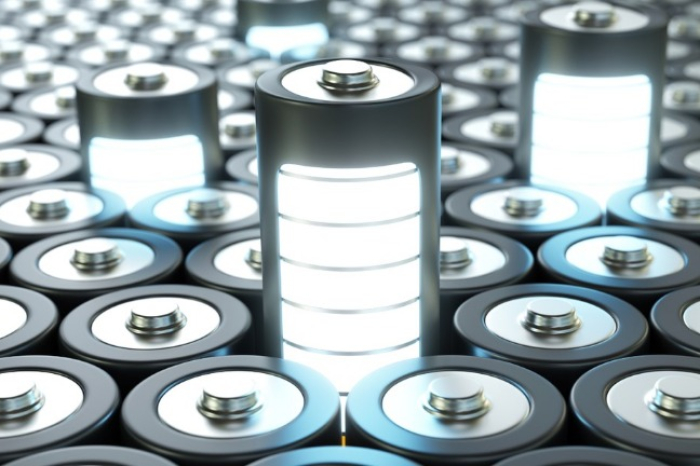Samsung SDI, Hanwha Ocean to usher in battery-driven submarine era
The Korean firms will begin testing their jointly developed lithium-ion battery system for submarines in Q3
By Apr 21, 2025 (Gmt+09:00)
LG Chem to sell water filter business to Glenwood PE for $692 million


KT&G eyes overseas M&A after rejecting activist fund's offer


Kyobo Life poised to buy Japan’s SBI Group-owned savings bank


StockX in merger talks with Naver’s online reseller Kream


Meritz backs half of ex-manager’s $210 mn hedge fund



Hanwha Ocean Co. and Samsung SDI Co. will start evaluating their jointly developed lithium-ion battery system for a submarine with South Korea’s Navy later this year, a move expected to usher in a new era for the country’s overall ship construction industry.
According to the Korean defense industry, Samsung SDI, Hanwha Ocean and Hanwha Aerospace Co. will carry out the final performance evaluation of a submarine battery system with the South Korean Navy in the third quarter.
The Navy will test the prototype submarine battery jointly developed by the three Korean companies.
If it passes the final test, the three partners are expected to start producing submarine batteries late this year, with a plan to deliver the batteries to the Navy for real use in 2028.
Samsung SDI, Korea’s second-largest battery maker, Hanwha Ocean and Hanwha Aerospace have been working together for years to develop the lithium-ion battery system for submarines.
Hanwha Ocean, Korea’s second-largest shipbuilder, is the country’s leading submarine and warship builder, and its sibling Hanwha Aerospace is the country’s leading defense and aerospace developer.
A BREAKTHROUGH
If the new battery propulsion system is approved, it is expected to serve as a breakthrough in not only submarine construction but also the overall shipbuilding sector in Korea.

Currently, the major power system of a submarine is a diesel engine supported by a lead-acid battery.
Submarines thus have to stay on the surface of the water to charge the lead-acid battery with the diesel engine for use during underwater operations.
The new battery system developed by the Samsung SDI-Hanwha consortium uses lithium-ion batteries as a submarine’s main propulsion system and a diesel engine as a supporting system.
Backed by an energy storage system, the newly developed lithium-ion battery system will be used both on and beneath the surface of the water.
The lithium-ion battery for a submarine is touted as an ideal eco-friendly submarine power system, which can also help reduce fuel costs.
Because the lithium-ion battery has a bigger capacity than that of the lead-acid battery, the underwater operation time of a lithium-ion battery-powered submarine is also expected to be double that of the diesel engine-lead-acid battery combination.
The battery propulsion system also has tactical advantages, like the ability to avoid sonar detection thanks to its nearly soundless operation.
LEAD TO ELECTRIFICATION IN THE PRIVATE SHIPBUILDING SECTOR

The successful application of the lithium-ion battery system to the Navy’s submarine is expected to mark a turning point in the country’s shipbuilding industry, analysts said.
Private businesses have been reluctant to develop the lithium-ion battery system for submarines or ships due to its high development costs.
The vessel battery system must have enough power to sail for a long period without charging and requires higher safety standards.
Developing the battery propulsion system for vessels that meet such high standards has been seen as too costly.
But if companies build related technology through military-led projects, their development costs could drop, said a battery industry official.
The lowered cost is expected to lead to active electrification in the vessel power system in the private sector, led by Korea’s other leading shipbuilders – HD Hyundai Heavy Industries Co. and Samsung Heavy Industries Co. – as well as major battery makers, LG Energy Solution Ltd. and SK On Co.
Foreign shipbuilders and battery makers have also been actively developing lithium-ion battery power systems.
With more players, the migration toward the zero-emission battery power system for ships is expected to gain traction.
According to Global Market Insights, the global electric power-driven vessel market is forecast to expand from $4 billion in 2023 to $28 billion in 2032.
Write to Sang Hoon Sung at uphoon@hankyung.com
Sookyung Seo edited this article.
-
 BatteriesSamsung SDI launches mass production of 46 mm-diameter batteries
BatteriesSamsung SDI launches mass production of 46 mm-diameter batteriesApr 01, 2025 (Gmt+09:00)
1 Min read -
 Shipping & ShipbuildingKorea’s Hanwha Ocean sends USNS Wally Schirra back to theater after MRO
Shipping & ShipbuildingKorea’s Hanwha Ocean sends USNS Wally Schirra back to theater after MROMar 14, 2025 (Gmt+09:00)
5 Min read -
 Shipping & ShipbuildingHD Korea Shipbuilding premieres nuclear-powered ship design
Shipping & ShipbuildingHD Korea Shipbuilding premieres nuclear-powered ship designFeb 13, 2025 (Gmt+09:00)
3 Min read -
 BatteriesSamsung SDI, GM to build $3.5 bn EV battery plant in US
BatteriesSamsung SDI, GM to build $3.5 bn EV battery plant in USAug 28, 2024 (Gmt+09:00)
2 Min read -
 Corporate restructuringHanwha Aerospace to spin off non-core units for defense sector
Corporate restructuringHanwha Aerospace to spin off non-core units for defense sectorAug 14, 2024 (Gmt+09:00)
1 Min read -
 Mergers & AcquisitionsDaewoo Shipbuilding enters new chapter as Hanwha Ocean
Mergers & AcquisitionsDaewoo Shipbuilding enters new chapter as Hanwha OceanMay 23, 2023 (Gmt+09:00)
2 Min read -
 Carbon neutralityHD Hyundai forms S.Korea's first integrated carbon footprint team in shipbuilding
Carbon neutralityHD Hyundai forms S.Korea's first integrated carbon footprint team in shipbuildingMar 17, 2023 (Gmt+09:00)
1 Min read


